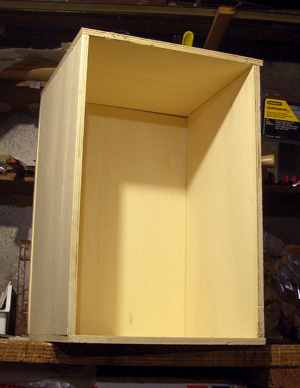
So, the wood. My impression is that the back, sides, top, and bottom of the cajon are to be made with the thickest heaviest wood you care to use, as if one were building a bass speaker cabinet. Generally 1/2-inch to 3/4-inch plywood is appropriate. I used 1/2-inch which, frankly, seemed plenty strong to handle any bass oscillations that came its way, and seems to be the most standard size used.
The front striking face, or tapa, must be rigid, but Ocaña points out that it shouldn't be too dense. The selection of the tapa wood is very important. Sounds like the typical soundboard ideal of "strong and light" comes in to play here, perhaps with more emphasis on the "strong" than you would have with, say, a guitar top, since you will be striking the tapa directly, and since there are no braces behind it. Note that the normal playing of the cajon is somewhere between a membranophone and a resonant top: in terms of the "kick" sound, you are largely relying on the force of the air generated by the compression of the space inside the instrument rather than any "ringing" of the top; but, without the ringing of the top (both at the 40-60 Hz kind of zone and the higher overtones) you have a pretty lifeless thud. Since you don't play the tapa in the center when you are making the "kick" sound (rather, more towards the top) it maybe doesn't have to be the toughest wood in the world. Many pro cajones use solid wood tops. I don't know how much that's about sound and how much that's about rare-or-fancy-wood fetish. This may be one sound application where plywood works just as well, but i really can't say. Undoubtedly you would have to know what you were doing in selecting that piece, since plywood does have the advantage of greater consistency (not to mention a higher degree of resistance to humidity, temperature, etc.)
Cajon builder Michael Kotzen weighs in on the issue of solid-wood tapas: "I’ve built quite a few solid tapas from both spruce & figured maple. They are a bit fragile, best used for studio use. Bracing helps. I generally finish both sides. The cajon in the upper left of my home page has a bookmatched figured maple tapa." Not sure what exactly he means by "bracing" in this context, but you could email him (and tell me what he says.) Similarly, other builders (luthiers, actually) have cautioned against the risk of the tapa splitting due to temperature/humidity changes or playing impact: a guitar top has substantial bracing behind it, which holds it together and strengthens it considerably, but such bracing would likely hurt a cajon's sound (although i'm interested to hear some bracing ideas...)
The plywood for the tapa can seem hopelessly flimsy when you first evaluate it, but once it is all screwed down to the face it should do fine. This cajon used 1/8-inch birch 3-ply. There were alternative "strong and light" plywoods at the supplier. I would consider using a thicker wood for the face, but again, without playing lots of cajones, i'm not sure. All of the candidates seemed to have much more flexibility along one axis than the other (presumably because with 3-ply, the two outer layers of wood are aligned in grain, with only the single inner layer at 90 degrees to those). This undoubtedly affects how the top resonates (maybe for good, maybe not); i took a guess and cut the tapa so that the outer grains ran vertically. If thicker wood could be used for the tapa, then perhaps 4-ply wouldn't have this issue, for whatever that's worth. "Aircraft-grade" plywood sounded tempting, but my rough information on that is that the grains of the plywood layers are not 90-degrees to each other; so it's not as rigid and even more biased to flexibilty along a certain axis (apparently because the wood is intended to be shaped.)
It seems that there must be some technique to shaping the tapa, but i found no information. Ocaña does have instructions on how to flatten the tapa of store-bought instruments, so perhaps flat is best. I did iron my tapa (low heat, no steam) before affixing it, as he recommends doing for tapas that are warped.

 This cajon has the typical strong frame that goes behind the tapa. But there is also an additional frame in the back to form the frame against which the door can seal (only two pieces required for that -- shown). These pieces are all made of hickory (a hardwood is strongly recommended; also, in this design, standard zither pins were used as the snare tensioners, and such pins work best in hard woods.) Shown here are the frame pieces (not actually glued; depending on your methods, it probably doesn't make sense to assemble the frame separately.)
This cajon has the typical strong frame that goes behind the tapa. But there is also an additional frame in the back to form the frame against which the door can seal (only two pieces required for that -- shown). These pieces are all made of hickory (a hardwood is strongly recommended; also, in this design, standard zither pins were used as the snare tensioners, and such pins work best in hard woods.) Shown here are the frame pieces (not actually glued; depending on your methods, it probably doesn't make sense to assemble the frame separately.)The unglued wall pieces are also shown freestanding to illustrate the basic idea.